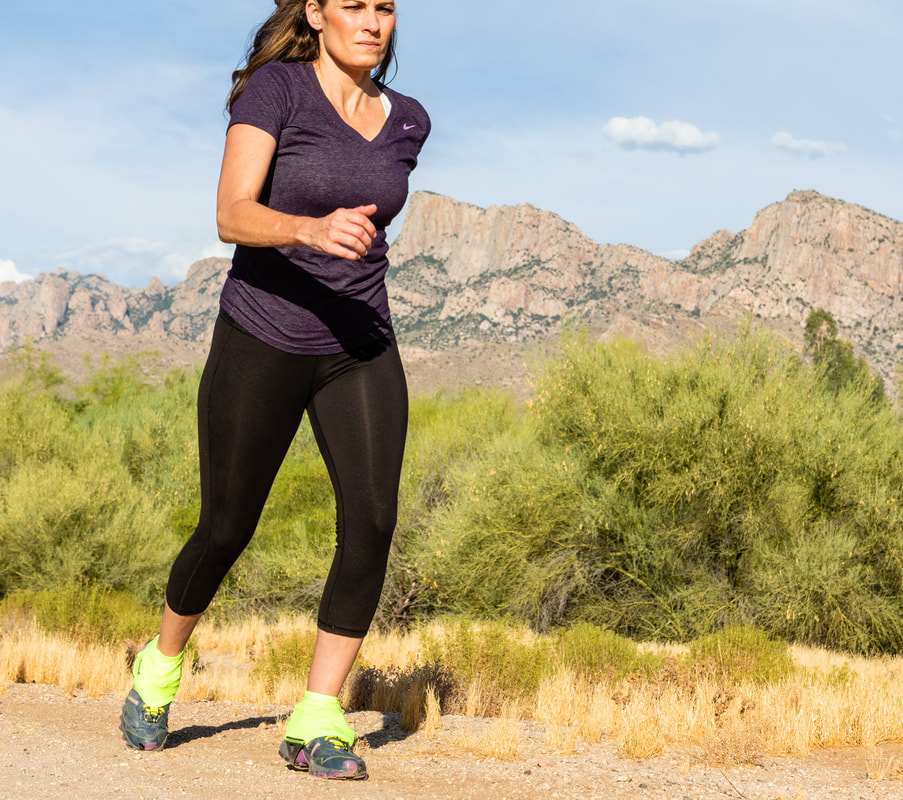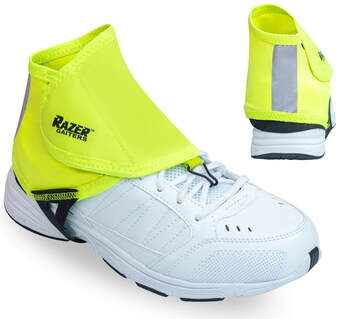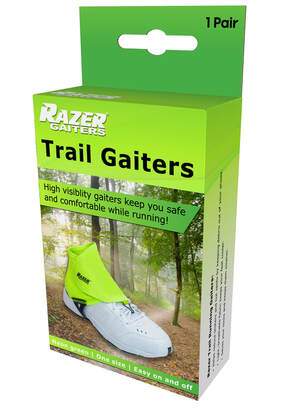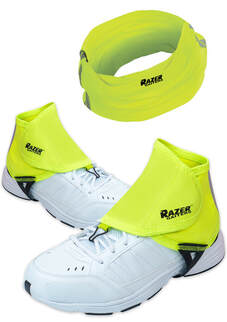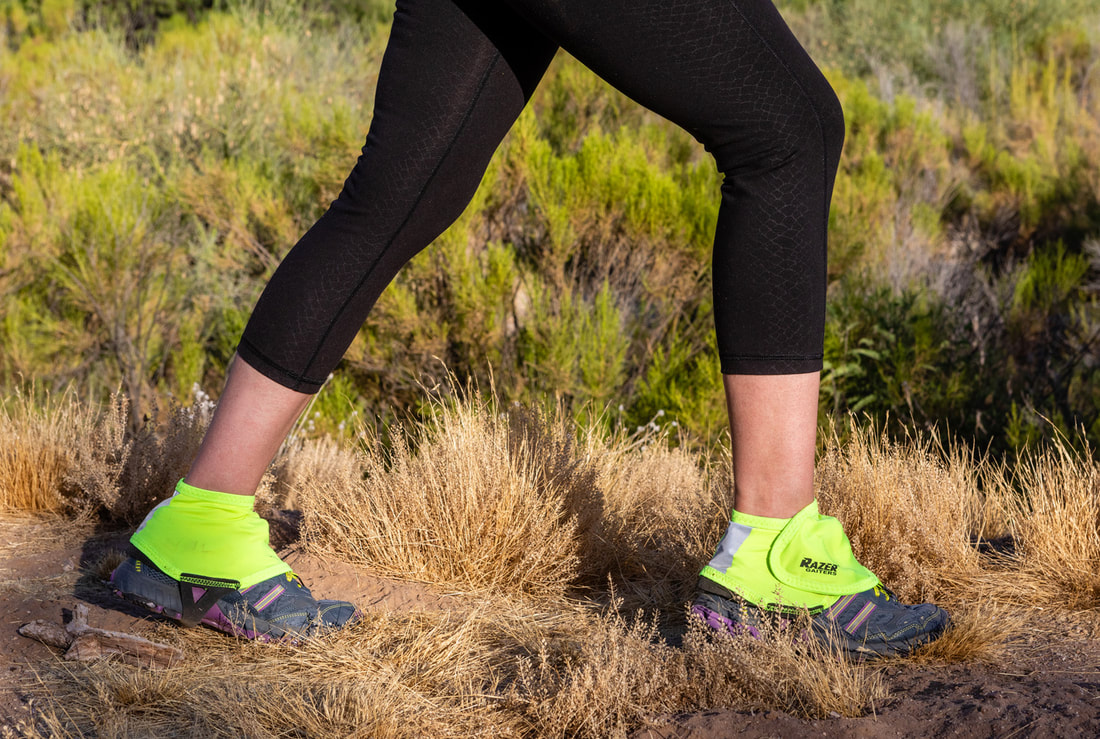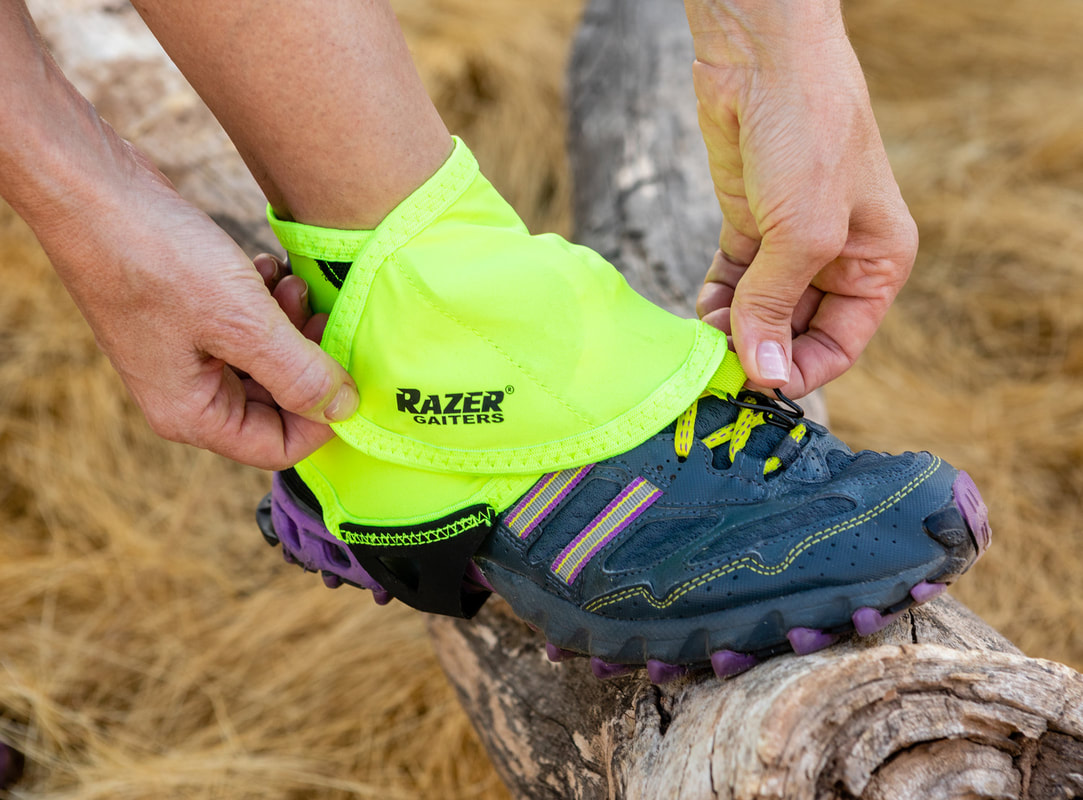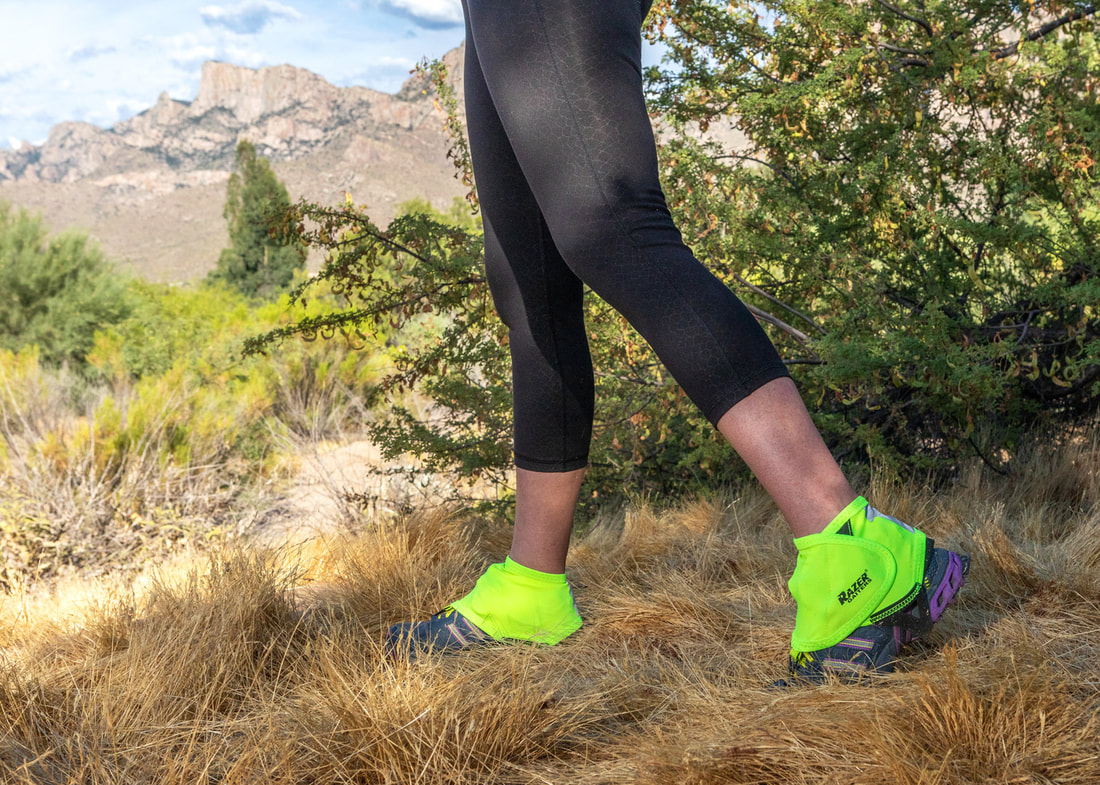Razer Trail Running Gaiters
|
If you are an off-road runner, trail gaiters are an essential part of your gear. Their purpose is simple: to prevent sand, dirt, prickles, mud, and gravel from getting in your shoes and causing irritation. Also saves your socks and keeps them cleaner! The gaiter height you needs depends on how much protection you want. Shorter ankle gaiters like these are made for trail running and summer hiking. A lesser-known use for Razer Trail Gaiters is to wear while doing yardwork to keep grass clippings, bark dust, mulch, and dirt out of your shoes. Size Large. Best fit is for ankle circumference of 9-10 inches. FREE SHIPPING!
How to wear gaiters:
|
Testimonials:
• "The first thing I noticed about this running gaiters for shoes, it has a clip to hook onto your lace. It holds the gaiter tight in place to not allow debris or bugs in your shoes while on a trail hike or running. In addition the material is durable but lightweight for summer use."
• "Good product. I wear while running and feel seen without the reflective gear getting in the way. I really like the trail gaiters."
• "Good product. I wear while running and feel seen without the reflective gear getting in the way. I really like the trail gaiters."
Need to ship best running gaiters outside of the USA? Please purchase trail running shoe gaiters through our listing on eBay. Click here for international orders of trail running gaiters.
Tips for Off-Road Running on Trails
When you’re ready to pound some terra firma instead of pavement, these helpful tips from Runner’s World and REI can help reduce the risk of injury and answer are gaiters worth it and what are gaiters for:
Adopt good posture. Shortening your stride can make you more agile and able to react quickly to obstacles. You’ll also be able to lengthen a single stride when needed—to avoid landing on a rock or muddy patch, for example. Keep your gaze 10-15 feet ahead and scan the terrain for obstacles. Hunched shoulders put stress on your back and rob your lungs of inflation space. They are also a sign you’re too tense, so take a moment to relax them. Then hold your shoulders straight, align them with your back and lean your whole body slightly forward as you run. Keep your hands in relaxed fists. Orient your arms so they are perpendicular to your torso, rather than pumping diagonally across it. Your fist should lightly graze the side of your running shorts on each swing. Having an efficient swing motion helps you build forward and upward momentum through your entire torso, rather than relying solely on your legs. When running uphill, maintain a proud posture and pump your elbows back to propel your body forward and upward. The main thing to focus on is to lean into the ground and use your forward momentum.
Wear the right shoes. If you’re going to weave trail running into your life, it’s wise to invest in a pair of trail running shoes. They differ from road-running shoes in that they’re often beefier to handle rugged terrain but also lower profile (lower to the ground), which reduces the chance of ankle rolls with a high heel. The proper tread offers better traction on muddy, wet trails. It can also help you brake when needed on steep descents. Trail running shoes should fit snug in the heel but have room in the toe box. Once laced/tightened you should not be able to slide your foot out of the shoe. You don’t need a new pair of shoes your first time out, but eventually you will want something more substantial if you find you like trail running and plan to continue. Once you buy a pair, take care of them. After a wet or muddy run, remove the insoles, wash off the mud, and stuff with newspaper or paper towels to dry. You’ll be so glad you did this at the end of a run instead of throwing crusty, muddy shoes in the back of the closet and having to deal with them several days later. When it comes to accessories, remember that running gaiters keep dirt, mud, gravel, and more out of your shoes and keep your socks cleaner at the same time!
Know the rules of the trail. Yield to other trail users (equestrian, hikers, mountain bikers). Generally, downhill runners should yield to uphill runners because the effort to stop and restart on the uphill is greater, and downhill runners often have a better angle of vision. But when in doubt, just be kind and courteous regardless of whether you’re headed up or down. Stay on marked trails and run through puddles, not around them (making the trail wider). Leave no trace, and don’t litter. Wearing best running gaiters, runners should yield to bikes, it's so much easier to stop and start on foot than it is on a bike.
Adopt good posture. Shortening your stride can make you more agile and able to react quickly to obstacles. You’ll also be able to lengthen a single stride when needed—to avoid landing on a rock or muddy patch, for example. Keep your gaze 10-15 feet ahead and scan the terrain for obstacles. Hunched shoulders put stress on your back and rob your lungs of inflation space. They are also a sign you’re too tense, so take a moment to relax them. Then hold your shoulders straight, align them with your back and lean your whole body slightly forward as you run. Keep your hands in relaxed fists. Orient your arms so they are perpendicular to your torso, rather than pumping diagonally across it. Your fist should lightly graze the side of your running shorts on each swing. Having an efficient swing motion helps you build forward and upward momentum through your entire torso, rather than relying solely on your legs. When running uphill, maintain a proud posture and pump your elbows back to propel your body forward and upward. The main thing to focus on is to lean into the ground and use your forward momentum.
Wear the right shoes. If you’re going to weave trail running into your life, it’s wise to invest in a pair of trail running shoes. They differ from road-running shoes in that they’re often beefier to handle rugged terrain but also lower profile (lower to the ground), which reduces the chance of ankle rolls with a high heel. The proper tread offers better traction on muddy, wet trails. It can also help you brake when needed on steep descents. Trail running shoes should fit snug in the heel but have room in the toe box. Once laced/tightened you should not be able to slide your foot out of the shoe. You don’t need a new pair of shoes your first time out, but eventually you will want something more substantial if you find you like trail running and plan to continue. Once you buy a pair, take care of them. After a wet or muddy run, remove the insoles, wash off the mud, and stuff with newspaper or paper towels to dry. You’ll be so glad you did this at the end of a run instead of throwing crusty, muddy shoes in the back of the closet and having to deal with them several days later. When it comes to accessories, remember that running gaiters keep dirt, mud, gravel, and more out of your shoes and keep your socks cleaner at the same time!
Know the rules of the trail. Yield to other trail users (equestrian, hikers, mountain bikers). Generally, downhill runners should yield to uphill runners because the effort to stop and restart on the uphill is greater, and downhill runners often have a better angle of vision. But when in doubt, just be kind and courteous regardless of whether you’re headed up or down. Stay on marked trails and run through puddles, not around them (making the trail wider). Leave no trace, and don’t litter. Wearing best running gaiters, runners should yield to bikes, it's so much easier to stop and start on foot than it is on a bike.
